
One thing I always focus on in my classes is opening the chest to create space for more breath, and while we yogis always think about backbends and contracting the back muscles for chest opening, sometimes we need to bring our attention to the muscles on the front body. For example, the small pectoralis minor is hidden beneath the pectoralis major; despite its size, it is a vitally important muscle for shoulder health in particular, and overall health in general. The pectoralis minor originates on the third, fourth, and fifth ribs and inserts on the coracoid process of the scapula; thus, this little muscle connects the shoulder blade to the rib cage. Its major function is to help elevate the rib cage during inhalation, allowing for full, deep breathing. That is in a perfect world.
Most of us, because of our daily routines, do not have full range of motion in the pec minor. We spend so much time hunching with our shoulder internally rotated and the shoulder blades protracted—in front of computers, over our steering wheels, leaning on a counter while chopping vegetables and other food for meals, hunching over flower beds when gardening, and so forth—that this muscle is chronically shortened, pulling the shoulder blades forward, and compromising the ability of the rib cage to expand. In addition, when this muscle is compressed, the major blood vessels of the arm as well as the brachial plexus (nerves that innervate the arm) that run under it are also compressed and their function is compromised, causing numbness and poor circulation. We need to reverse this habitual posture for our breath, our shoulder health (range of movement and flexibility), and our general health (being able to reach overhead into a cabinet, and behind us to scratch our own back, for example).
The good news is that the “damage” can be easily repaired with a ball routine and a few stretches that take very little time. Since I spend most of my work day in front of a computer, I’ve developed a special fondness for rehydrating and mobilizing my pec minor. My favorite sequence is to take a YTU therapy ball and a block to the wall, placing the ball on the block and then rolling from just under the inner collarbone to the outer collarbone, pressing gently on the coracoid process (a nubby protrusion on the shoulder blade that pokes out into the armpit area) when I reach it. That movement also rolls out the subclavius which acts to elevate the first rib during inhalation—a bonus! Then I move on to Shoulder Flossing Variation #1 (using a strap to take the shoulder girdle back and forth through circumduction) for four or five sets (more if I have time). You could stop there and feel the benefits, but if there’s more time, I like to add Bridge Arms into Prasarita, and Open Sesame. Try these chest opening exercises — your breath won’t be the same.
Read more about your diaphragm.
Learn about our stress relief products.
Learn about our Therapy Ball Programs.


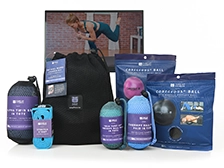
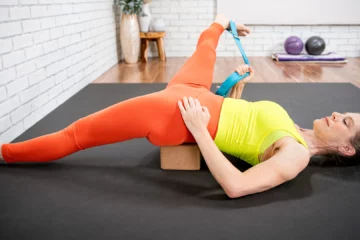

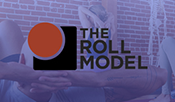
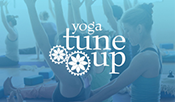


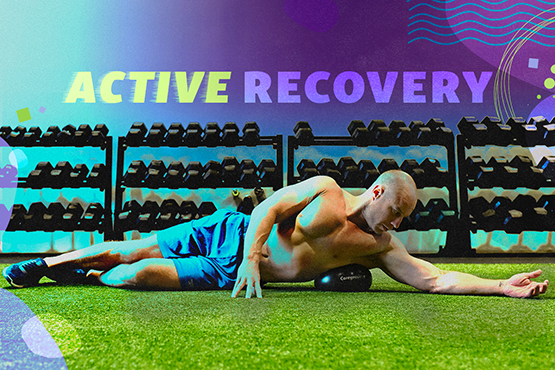
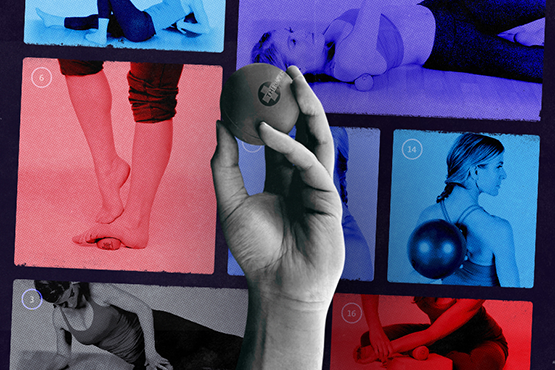
Yes! I am a big pec minor fan and so agree that in yoga people tend to forget to stretch it compared to how much they work on contracting the back body to feel ‘open’. However I hadn’t really though about the effect of a tight pec minor on the blood vessels and nerves below, thanks for sharing a new area for me to look into.
I used to have the nickname E.T. because of my hunched shoulders and jutted out head. I have been working a long time to reposition myself into a better alignment for more efficient movement and a more appealing aesthetic on the stage while I’m performing. I’m interested in implementing these ideas into my practice. Hopefully I will be able to breathe better, and feel better with a new sense of poise!
Thanks for this mini sequence to open pec minor. When I’m not teaching, I spend a significant amount of time driving and at my desk. This sounds like an easy thing to do once I get to the studio before class. When I breathe better my class breathes better!
I definitely appreciate this aricle! Rolling out the Pec’s in order to breath better sounds so worthwhile!
I love this technique. I know when I first experienced what Yoga Tune Up balls felt like on that area, it was clear I’d never given them any thought before! I am definitely going to try this sequence and see how my breathing and range of motion improves.
As someone who has spent thousands of hours in front of computers the last 10 years, my pec minors were sleeping like hibernating bears during a LONG winter. Using the block for this release is a game-changer and adding the shoulder flossing after is a great combo. A new addition to my daily routine for sure.
Dawn this is a really good prescriptive article on releasing and ironing out the chronic tightness in the pec minor in our culture. The interweaving of the YTU exercises like shoulder flossing paired with the rolling of the pec minor and sub clavius is a potent cure for better breath.
Pec minor also gets very tight on people who’ve had asthma (or smoked), or tend to breath into their upper ribs from an over stimulated sympathetic system, or generally poor breathing habits. I looove the YTU Ball in this area. All 3 ball sizes actually; each offering something a little different. Up against the block (braced on a wall) or on a corner of a wall, with exaggerated internal rotation and some attempt at arm movement, is my heaven/hell fav 😉
Great post Dawn – I love rolling out the pec minor on the wall with a block and I shoulder floss first thing in the morning with a shirt. I am not familiar with Bridge Arms into Prasarita and Open Sesame? I am a little exhausted from Level 1 training, but couldn’t find it… Thank you in advance for the help! Sounds like these two exercises would be a natural fit to my routine and to share them with my students.
I did this exercise with a student who had been unable to sleep on one side of her body for over a year. Once introduced to the balls and this particular YTU exercise, she can now sleep on both sides. Such amazing results!
Are there more specific directions for this exercise and/or visual on how to do this exercise? Are they in your upper body therapy ball it? I have trouble understanking “take a block to the wall” Am I standing? How is the block secured so I can roll ball and shoulder over it? Please let me know soonest as I have chronic pain in my right lower shoulder blade. Doctors have ruled out cardiac, gall bladder, etc. Thanks.
Sweet post Dawn! I often see many of my classmates in school trying to stretch out there backs between classes, and think that they are missing a complete half of the equation. Breathing easier feels so amazing and natural! Thanks!
The importance of exploring each of our muscles with care and compassion seems to be a plan for healing.
Subclavius muscle is the smallest of the four pectoral muscles. It originats on the first rib right at the junction with the costal cartilage. It inserts on the underside, the inferior surface of the clavicle.And mine is usually quite sore when I massage it.
So when you are , creating methods to explore and expand yourself with your muscles, and expressing the release of your trauma from these areas with the intention of achieving a heather body, remember to focus on self care.
[…] Ease Your Breath By Waking Up Pectoralis Minor .broken_link, a.broken_link { text-decoration: line-through; } […]
My physical therapist friend is always telling me that one thing I need to focus on opening my pecs, opening my pecs, opening my pecs. I don’t always follow through though because I find the pecs are not as easy to self-massage as the posterier shoulder muscles. But now I have the yoga tune up balls and voila! I love how we were taught in class to use balls with the yoga block, along with our body weight to ease into those very ouchy muscles. Great info.
I love how you have shared such a wealth of knowledge in a short blog. I also love the poses you mentioned, even though open sesame feel like nothing to me, but the therapy balls feels like so so much! Thanks for shining light on the need to bring attention to our pec minor instead of simply “opening our hearts”. My body worker has on many occasions dug in my armpit, found my pec minor, and pressed on it while I moved my shoulder through circumduction while I pretty much screamed. It is so nice to know that there are ways we can bring some of this same relief to ourselves. Yay!
As I was reading this article, I suddenly became aware of my hunched-over posture! I am new to YTU, and I am so excited to learn about all of these new techniques. I am filled with renewed hope for alleviation of my students’ physical ailments and imbalances, as well as my own! I’m off to try Dawn’s ball rolling/stretch routine!
It still baffles me how much posture matters– it truly affects our wellbeing. I just gave these exercises a try after a long day of yoga training… and definitely noticed a difference in my chest, so open!
This is a great article bringing awareness to how poor posture and bad daily habits affect everything including our breathing. When the muscular connection is made from the rib cage to the scapula as with the Pectoralis Minor highlighted here, it is very apparent how the breath can be compromised by the shortening of a muscle which brings the shoulder blades forward in essence ‘hollowing out the chest.’ We can’t undo multiple days worth of ‘slumping over a computer, the steering wheel, our kitchen counters, etc. with one hour of Yoga class, even if it is dedicated to ‘heart opening.’ I like the suggestions you made of ball rolling placement followed by specific shoulder opening Yoga Tune Up poses. I’m going to try the sequence tonight and teach it in class next week. Thank you.
Breath is a subconscious part of many peoples’ everyday; but when we stop to think about how we breathe and where the breath can be directed a whole new world opens. I haven’t tried the above, I just got my YTU balls and am interested to explore all the areas in my body that will have a whole new awakening. With grateful breath!
I couldn’t agree more! Our Pec’s are so overworked and in need of some balance and love. Many times we are not connected to our bodies and don’t listen until it’s too late and there’s an injury which forces us to. Thanks for the reminder!
Many of my students have shoulder issues and my pecs are chronically tight . I like the idea of rolling out the tissues first with a therapy ball, and then increasing range of motion with shoulder flossing. This is an are where we all need work.
Thanks for the interesting article!!!
This article is fabulous Dawn!! Rolling out the subclavius muscles and shoulder flossing are both “life and breath” saving activities! Thank you so much for sharing this vital information on the YTU blog.